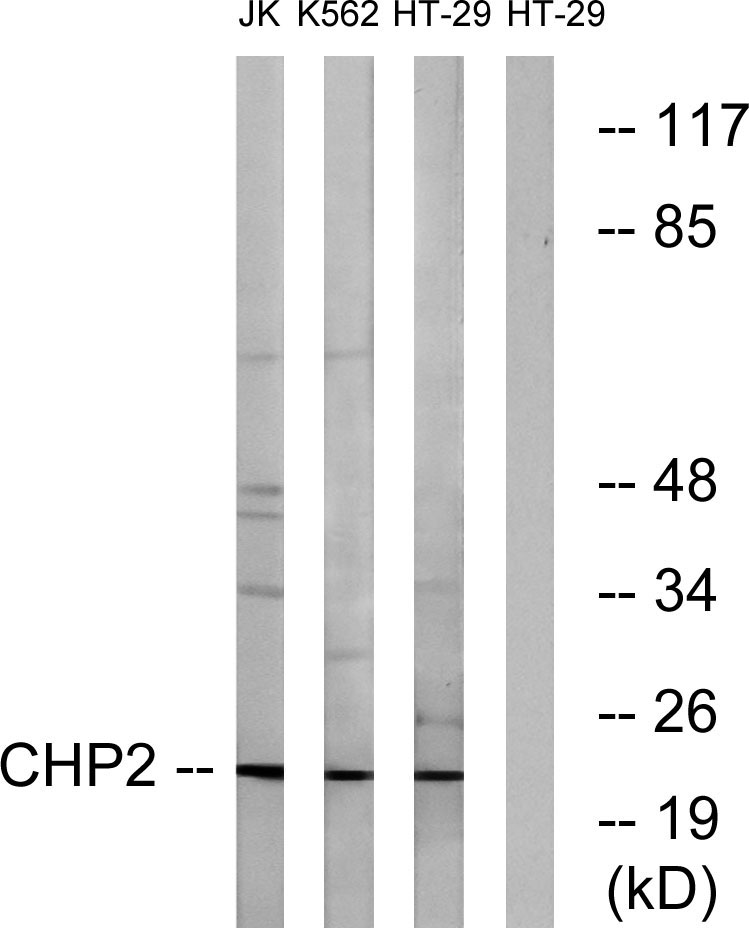CHP2 Polyclonal Antibody
- Catalog No.:YT0915
- Applications:WB;ELISA
- Reactivity:Human;Mouse;Rat
- Target:
- CHP2
- Gene Name:
- CHP2
- Protein Name:
- Calcineurin B homologous protein 2
- Human Gene Id:
- 63928
- Human Swiss Prot No:
- O43745
- Mouse Swiss Prot No:
- Q9D869
- Rat Gene Id:
- 308965
- Rat Swiss Prot No:
- Q810D1
- Immunogen:
- The antiserum was produced against synthesized peptide derived from human CHP2. AA range:101-150
- Specificity:
- CHP2 Polyclonal Antibody detects endogenous levels of CHP2 protein.
- Formulation:
- Liquid in PBS containing 50% glycerol, 0.5% BSA and 0.02% sodium azide.
- Source:
- Polyclonal, Rabbit,IgG
- Dilution:
- WB 1:500 - 1:2000. ELISA: 1:40000. Not yet tested in other applications.
- Purification:
- The antibody was affinity-purified from rabbit antiserum by affinity-chromatography using epitope-specific immunogen.
- Concentration:
- 1 mg/ml
- Storage Stability:
- -15°C to -25°C/1 year(Do not lower than -25°C)
- Other Name:
- CHP2;HCA520;Calcineurin B homologous protein 2;Hepatocellular carcinoma-associated antigen 520
- Observed Band(KD):
- 22kD
- Background:
- This gene product is a small calcium-binding protein that regulates cell pH by controlling plasma membrane-type Na+/H+ exchange activity. This protein shares sequence similarity with calcineurin B and can bind to and stimulate the protein phosphatase activity of calcineurin A (CnA) and functions in the calcineurin/NFAT (nuclear factor of activated T cells) signaling pathway. Another member of the CHP subfamily, Calcineurin B homologous protein 1, is located on Chromosome 15 and is an inhibitor of calcineurin activity and has a genetic phenotype associated with Parkinson's Disease (OMIM:606988). This gene was initially identified as a tumor-associated antigen and was previously referred to as Hepatocellular carcinoma-associated antigen 520. [provided by RefSeq, Jul 2013],
- Function:
- function:Binds to and activates SLC9A1/NHE1 in a serum-independent manner, thus increasing pH and protecting cells from serum deprivation-induced death.,similarity:Contains 4 EF-hand domains.,subunit:Binds to SLC9A1/NHE1.,tissue specificity:Expressed in malignantly transformed cells but not detected in normal tissues.,
- Subcellular Location:
- Nucleus . Cytoplasm . Cell membrane . Predominantly localized in a juxtanuclear region. Colocalizes with SLC9A3 in the juxtanuclear region and at the plasma membrane (By similarity). Exported from the nucleus to the cytoplasm through a nuclear export signal (NES) pathway. May shuttle between nucleus and cytoplasm. .
- Expression:
- Expressed in malignantly transformed cells but not detected in normal tissues.
- June 19-2018
- WESTERN IMMUNOBLOTTING PROTOCOL
- June 19-2018
- IMMUNOHISTOCHEMISTRY-PARAFFIN PROTOCOL
- June 19-2018
- IMMUNOFLUORESCENCE PROTOCOL
- September 08-2020
- FLOW-CYTOMEYRT-PROTOCOL
- May 20-2022
- Cell-Based ELISA│解您多样本WB检测之困扰
- July 13-2018
- CELL-BASED-ELISA-PROTOCOL-FOR-ACETYL-PROTEIN
- July 13-2018
- CELL-BASED-ELISA-PROTOCOL-FOR-PHOSPHO-PROTEIN
- July 13-2018
- Antibody-FAQs
- Products Images

- Western Blot analysis of various cells using CHP2 Polyclonal Antibody

- Western blot analysis of lysates from HT-29, K562, and Jurkat cells, using CHP2 Antibody. The lane on the right is blocked with the synthesized peptide.



